Nursing Assignment Paper
VerifiedAdded on 2022/11/13
|8
|2005
|285
AI Summary
This nursing assignment paper discusses mental illness, cultural interpretation, and nursing practice. It covers topics such as culturally safe care, mental health assessment, and supporting families of patients with psychological disorders. The paper also includes a case study of Justin, an Aboriginal Australian, and his mental health journey.
Contribute Materials
Your contribution can guide someone’s learning journey. Share your
documents today.
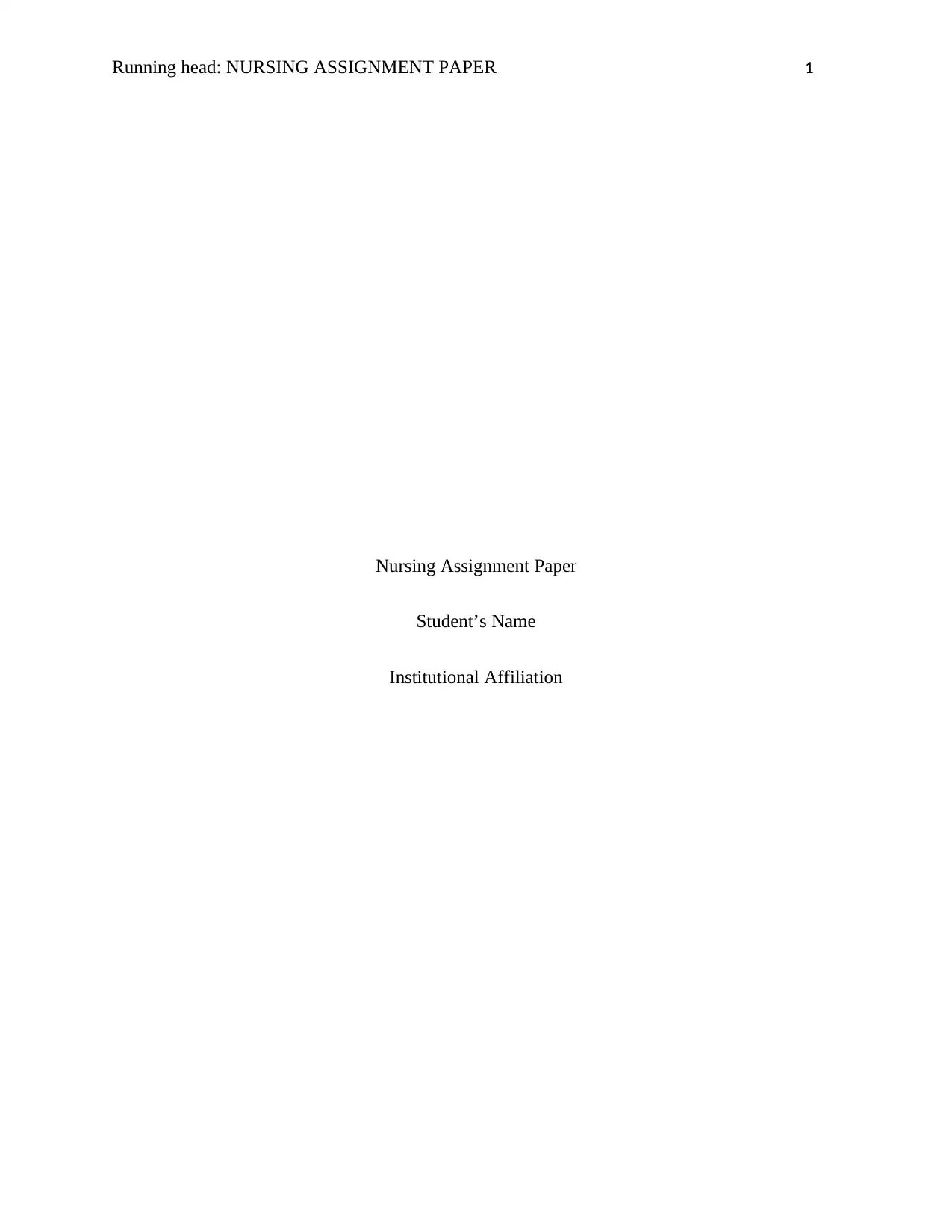
Running head: NURSING ASSIGNMENT PAPER 1
Nursing Assignment Paper
Student’s Name
Institutional Affiliation
Nursing Assignment Paper
Student’s Name
Institutional Affiliation
Secure Best Marks with AI Grader
Need help grading? Try our AI Grader for instant feedback on your assignments.
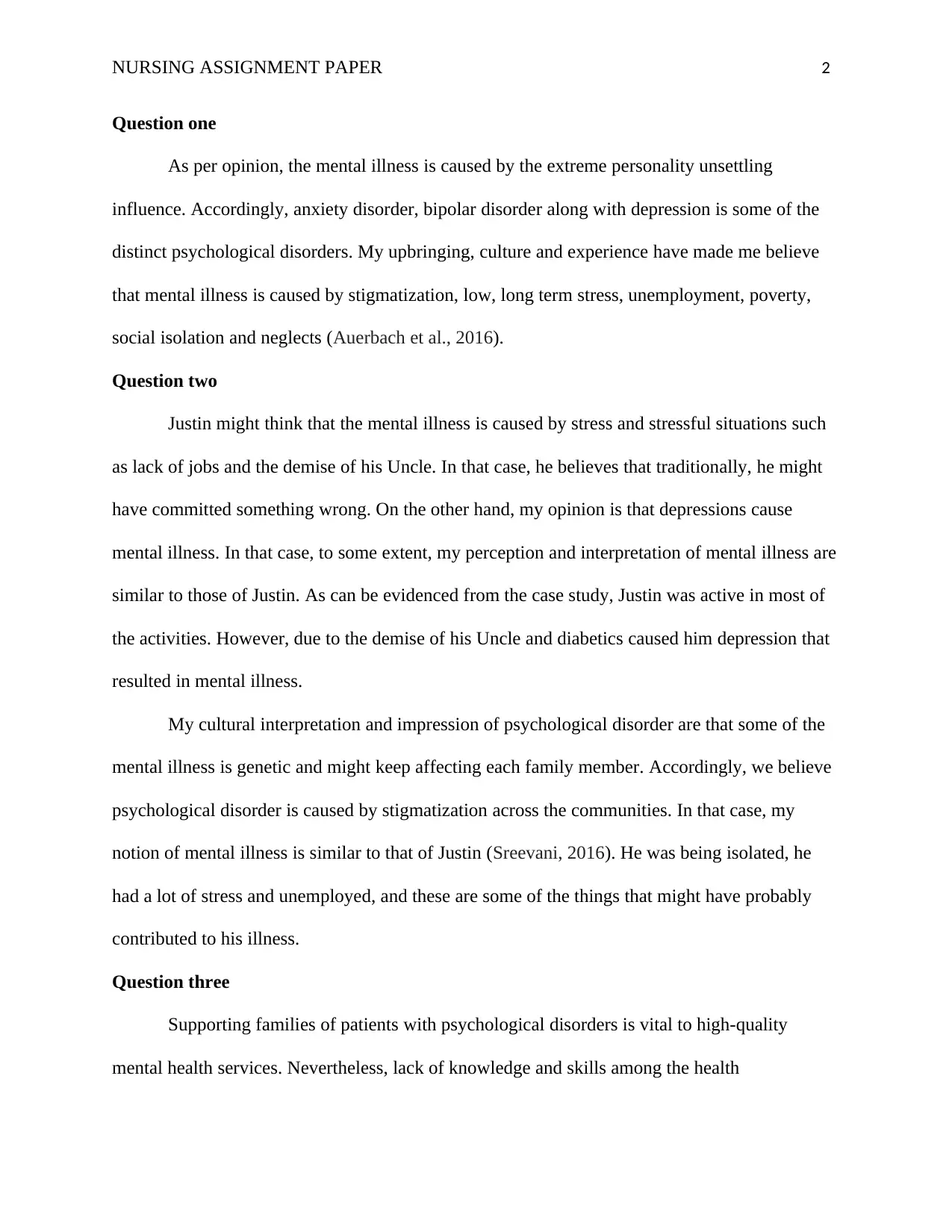
NURSING ASSIGNMENT PAPER 2
Question one
As per opinion, the mental illness is caused by the extreme personality unsettling
influence. Accordingly, anxiety disorder, bipolar disorder along with depression is some of the
distinct psychological disorders. My upbringing, culture and experience have made me believe
that mental illness is caused by stigmatization, low, long term stress, unemployment, poverty,
social isolation and neglects (Auerbach et al., 2016).
Question two
Justin might think that the mental illness is caused by stress and stressful situations such
as lack of jobs and the demise of his Uncle. In that case, he believes that traditionally, he might
have committed something wrong. On the other hand, my opinion is that depressions cause
mental illness. In that case, to some extent, my perception and interpretation of mental illness are
similar to those of Justin. As can be evidenced from the case study, Justin was active in most of
the activities. However, due to the demise of his Uncle and diabetics caused him depression that
resulted in mental illness.
My cultural interpretation and impression of psychological disorder are that some of the
mental illness is genetic and might keep affecting each family member. Accordingly, we believe
psychological disorder is caused by stigmatization across the communities. In that case, my
notion of mental illness is similar to that of Justin (Sreevani, 2016). He was being isolated, he
had a lot of stress and unemployed, and these are some of the things that might have probably
contributed to his illness.
Question three
Supporting families of patients with psychological disorders is vital to high-quality
mental health services. Nevertheless, lack of knowledge and skills among the health
Question one
As per opinion, the mental illness is caused by the extreme personality unsettling
influence. Accordingly, anxiety disorder, bipolar disorder along with depression is some of the
distinct psychological disorders. My upbringing, culture and experience have made me believe
that mental illness is caused by stigmatization, low, long term stress, unemployment, poverty,
social isolation and neglects (Auerbach et al., 2016).
Question two
Justin might think that the mental illness is caused by stress and stressful situations such
as lack of jobs and the demise of his Uncle. In that case, he believes that traditionally, he might
have committed something wrong. On the other hand, my opinion is that depressions cause
mental illness. In that case, to some extent, my perception and interpretation of mental illness are
similar to those of Justin. As can be evidenced from the case study, Justin was active in most of
the activities. However, due to the demise of his Uncle and diabetics caused him depression that
resulted in mental illness.
My cultural interpretation and impression of psychological disorder are that some of the
mental illness is genetic and might keep affecting each family member. Accordingly, we believe
psychological disorder is caused by stigmatization across the communities. In that case, my
notion of mental illness is similar to that of Justin (Sreevani, 2016). He was being isolated, he
had a lot of stress and unemployed, and these are some of the things that might have probably
contributed to his illness.
Question three
Supporting families of patients with psychological disorders is vital to high-quality
mental health services. Nevertheless, lack of knowledge and skills among the health
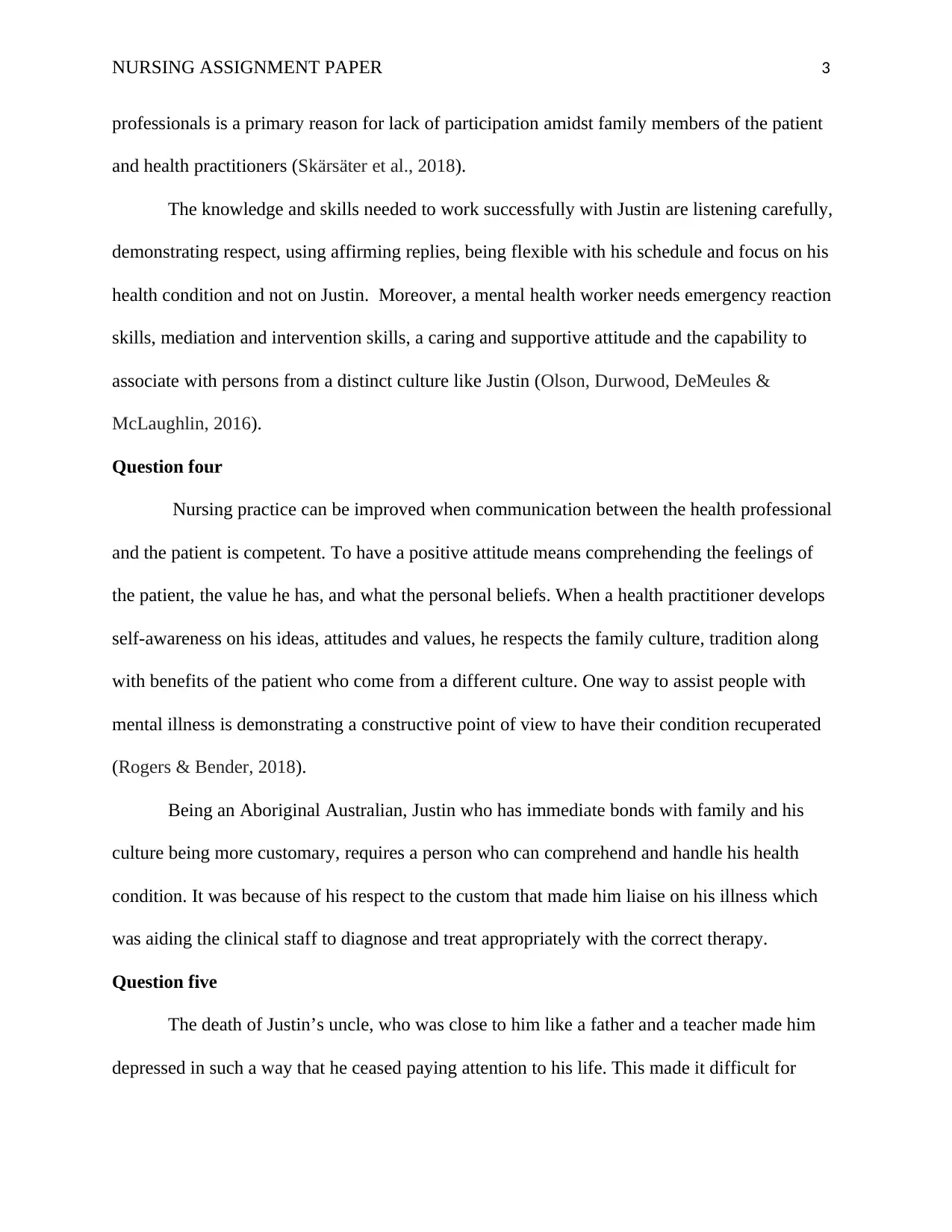
NURSING ASSIGNMENT PAPER 3
professionals is a primary reason for lack of participation amidst family members of the patient
and health practitioners (Skärsäter et al., 2018).
The knowledge and skills needed to work successfully with Justin are listening carefully,
demonstrating respect, using affirming replies, being flexible with his schedule and focus on his
health condition and not on Justin. Moreover, a mental health worker needs emergency reaction
skills, mediation and intervention skills, a caring and supportive attitude and the capability to
associate with persons from a distinct culture like Justin (Olson, Durwood, DeMeules &
McLaughlin, 2016).
Question four
Nursing practice can be improved when communication between the health professional
and the patient is competent. To have a positive attitude means comprehending the feelings of
the patient, the value he has, and what the personal beliefs. When a health practitioner develops
self-awareness on his ideas, attitudes and values, he respects the family culture, tradition along
with benefits of the patient who come from a different culture. One way to assist people with
mental illness is demonstrating a constructive point of view to have their condition recuperated
(Rogers & Bender, 2018).
Being an Aboriginal Australian, Justin who has immediate bonds with family and his
culture being more customary, requires a person who can comprehend and handle his health
condition. It was because of his respect to the custom that made him liaise on his illness which
was aiding the clinical staff to diagnose and treat appropriately with the correct therapy.
Question five
The death of Justin’s uncle, who was close to him like a father and a teacher made him
depressed in such a way that he ceased paying attention to his life. This made it difficult for
professionals is a primary reason for lack of participation amidst family members of the patient
and health practitioners (Skärsäter et al., 2018).
The knowledge and skills needed to work successfully with Justin are listening carefully,
demonstrating respect, using affirming replies, being flexible with his schedule and focus on his
health condition and not on Justin. Moreover, a mental health worker needs emergency reaction
skills, mediation and intervention skills, a caring and supportive attitude and the capability to
associate with persons from a distinct culture like Justin (Olson, Durwood, DeMeules &
McLaughlin, 2016).
Question four
Nursing practice can be improved when communication between the health professional
and the patient is competent. To have a positive attitude means comprehending the feelings of
the patient, the value he has, and what the personal beliefs. When a health practitioner develops
self-awareness on his ideas, attitudes and values, he respects the family culture, tradition along
with benefits of the patient who come from a different culture. One way to assist people with
mental illness is demonstrating a constructive point of view to have their condition recuperated
(Rogers & Bender, 2018).
Being an Aboriginal Australian, Justin who has immediate bonds with family and his
culture being more customary, requires a person who can comprehend and handle his health
condition. It was because of his respect to the custom that made him liaise on his illness which
was aiding the clinical staff to diagnose and treat appropriately with the correct therapy.
Question five
The death of Justin’s uncle, who was close to him like a father and a teacher made him
depressed in such a way that he ceased paying attention to his life. This made it difficult for
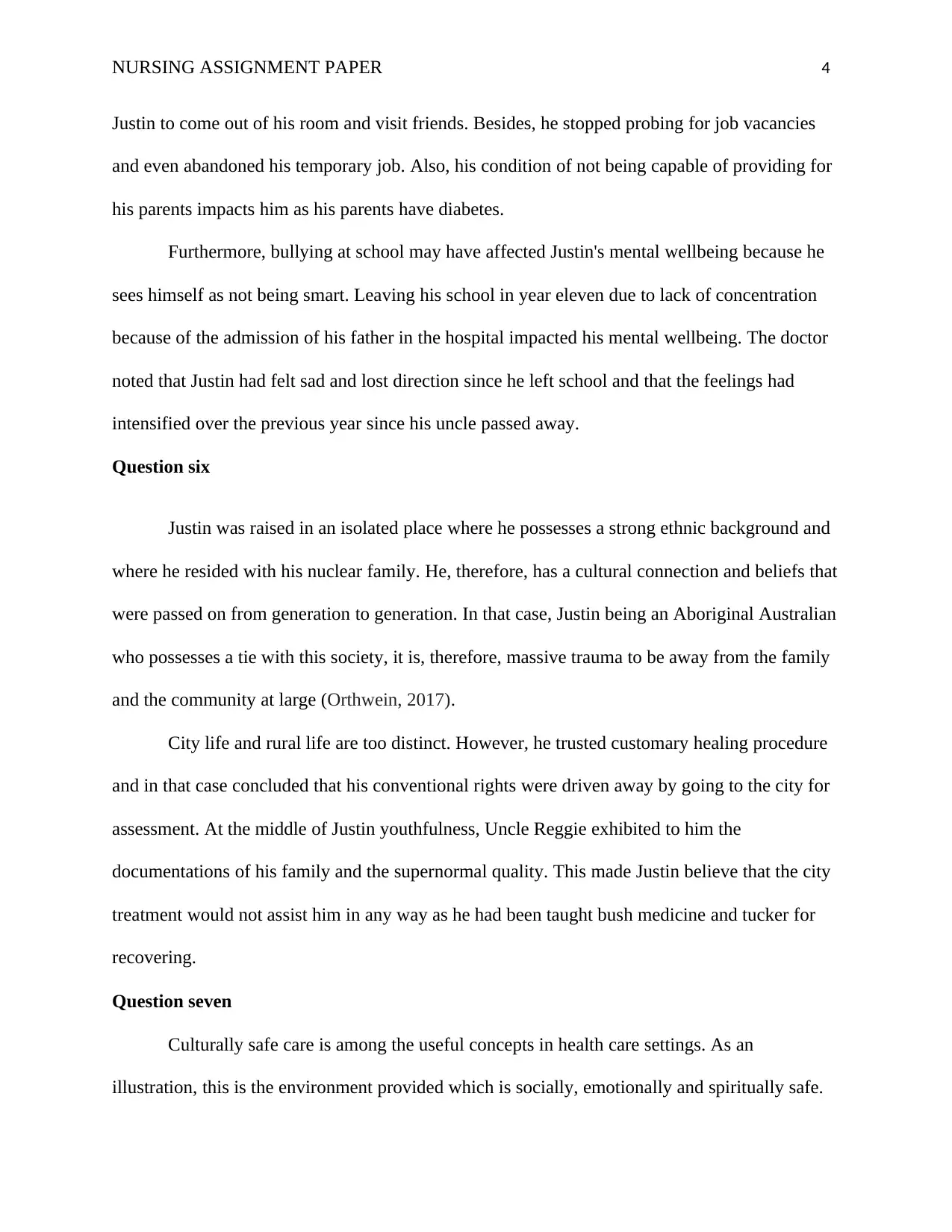
NURSING ASSIGNMENT PAPER 4
Justin to come out of his room and visit friends. Besides, he stopped probing for job vacancies
and even abandoned his temporary job. Also, his condition of not being capable of providing for
his parents impacts him as his parents have diabetes.
Furthermore, bullying at school may have affected Justin's mental wellbeing because he
sees himself as not being smart. Leaving his school in year eleven due to lack of concentration
because of the admission of his father in the hospital impacted his mental wellbeing. The doctor
noted that Justin had felt sad and lost direction since he left school and that the feelings had
intensified over the previous year since his uncle passed away.
Question six
Justin was raised in an isolated place where he possesses a strong ethnic background and
where he resided with his nuclear family. He, therefore, has a cultural connection and beliefs that
were passed on from generation to generation. In that case, Justin being an Aboriginal Australian
who possesses a tie with this society, it is, therefore, massive trauma to be away from the family
and the community at large (Orthwein, 2017).
City life and rural life are too distinct. However, he trusted customary healing procedure
and in that case concluded that his conventional rights were driven away by going to the city for
assessment. At the middle of Justin youthfulness, Uncle Reggie exhibited to him the
documentations of his family and the supernormal quality. This made Justin believe that the city
treatment would not assist him in any way as he had been taught bush medicine and tucker for
recovering.
Question seven
Culturally safe care is among the useful concepts in health care settings. As an
illustration, this is the environment provided which is socially, emotionally and spiritually safe.
Justin to come out of his room and visit friends. Besides, he stopped probing for job vacancies
and even abandoned his temporary job. Also, his condition of not being capable of providing for
his parents impacts him as his parents have diabetes.
Furthermore, bullying at school may have affected Justin's mental wellbeing because he
sees himself as not being smart. Leaving his school in year eleven due to lack of concentration
because of the admission of his father in the hospital impacted his mental wellbeing. The doctor
noted that Justin had felt sad and lost direction since he left school and that the feelings had
intensified over the previous year since his uncle passed away.
Question six
Justin was raised in an isolated place where he possesses a strong ethnic background and
where he resided with his nuclear family. He, therefore, has a cultural connection and beliefs that
were passed on from generation to generation. In that case, Justin being an Aboriginal Australian
who possesses a tie with this society, it is, therefore, massive trauma to be away from the family
and the community at large (Orthwein, 2017).
City life and rural life are too distinct. However, he trusted customary healing procedure
and in that case concluded that his conventional rights were driven away by going to the city for
assessment. At the middle of Justin youthfulness, Uncle Reggie exhibited to him the
documentations of his family and the supernormal quality. This made Justin believe that the city
treatment would not assist him in any way as he had been taught bush medicine and tucker for
recovering.
Question seven
Culturally safe care is among the useful concepts in health care settings. As an
illustration, this is the environment provided which is socially, emotionally and spiritually safe.
Secure Best Marks with AI Grader
Need help grading? Try our AI Grader for instant feedback on your assignments.
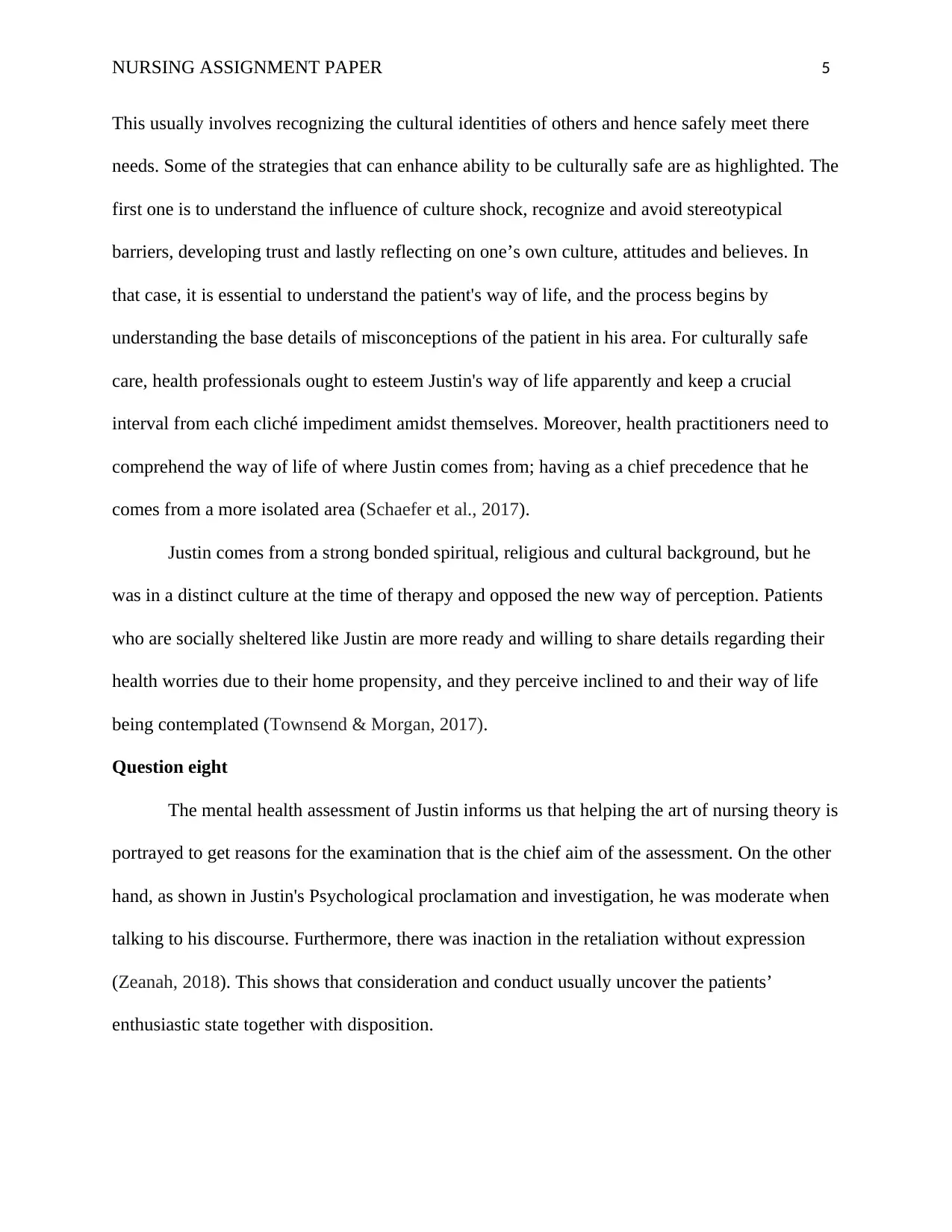
NURSING ASSIGNMENT PAPER 5
This usually involves recognizing the cultural identities of others and hence safely meet there
needs. Some of the strategies that can enhance ability to be culturally safe are as highlighted. The
first one is to understand the influence of culture shock, recognize and avoid stereotypical
barriers, developing trust and lastly reflecting on one’s own culture, attitudes and believes. In
that case, it is essential to understand the patient's way of life, and the process begins by
understanding the base details of misconceptions of the patient in his area. For culturally safe
care, health professionals ought to esteem Justin's way of life apparently and keep a crucial
interval from each cliché impediment amidst themselves. Moreover, health practitioners need to
comprehend the way of life of where Justin comes from; having as a chief precedence that he
comes from a more isolated area (Schaefer et al., 2017).
Justin comes from a strong bonded spiritual, religious and cultural background, but he
was in a distinct culture at the time of therapy and opposed the new way of perception. Patients
who are socially sheltered like Justin are more ready and willing to share details regarding their
health worries due to their home propensity, and they perceive inclined to and their way of life
being contemplated (Townsend & Morgan, 2017).
Question eight
The mental health assessment of Justin informs us that helping the art of nursing theory is
portrayed to get reasons for the examination that is the chief aim of the assessment. On the other
hand, as shown in Justin's Psychological proclamation and investigation, he was moderate when
talking to his discourse. Furthermore, there was inaction in the retaliation without expression
(Zeanah, 2018). This shows that consideration and conduct usually uncover the patients’
enthusiastic state together with disposition.
This usually involves recognizing the cultural identities of others and hence safely meet there
needs. Some of the strategies that can enhance ability to be culturally safe are as highlighted. The
first one is to understand the influence of culture shock, recognize and avoid stereotypical
barriers, developing trust and lastly reflecting on one’s own culture, attitudes and believes. In
that case, it is essential to understand the patient's way of life, and the process begins by
understanding the base details of misconceptions of the patient in his area. For culturally safe
care, health professionals ought to esteem Justin's way of life apparently and keep a crucial
interval from each cliché impediment amidst themselves. Moreover, health practitioners need to
comprehend the way of life of where Justin comes from; having as a chief precedence that he
comes from a more isolated area (Schaefer et al., 2017).
Justin comes from a strong bonded spiritual, religious and cultural background, but he
was in a distinct culture at the time of therapy and opposed the new way of perception. Patients
who are socially sheltered like Justin are more ready and willing to share details regarding their
health worries due to their home propensity, and they perceive inclined to and their way of life
being contemplated (Townsend & Morgan, 2017).
Question eight
The mental health assessment of Justin informs us that helping the art of nursing theory is
portrayed to get reasons for the examination that is the chief aim of the assessment. On the other
hand, as shown in Justin's Psychological proclamation and investigation, he was moderate when
talking to his discourse. Furthermore, there was inaction in the retaliation without expression
(Zeanah, 2018). This shows that consideration and conduct usually uncover the patients’
enthusiastic state together with disposition.
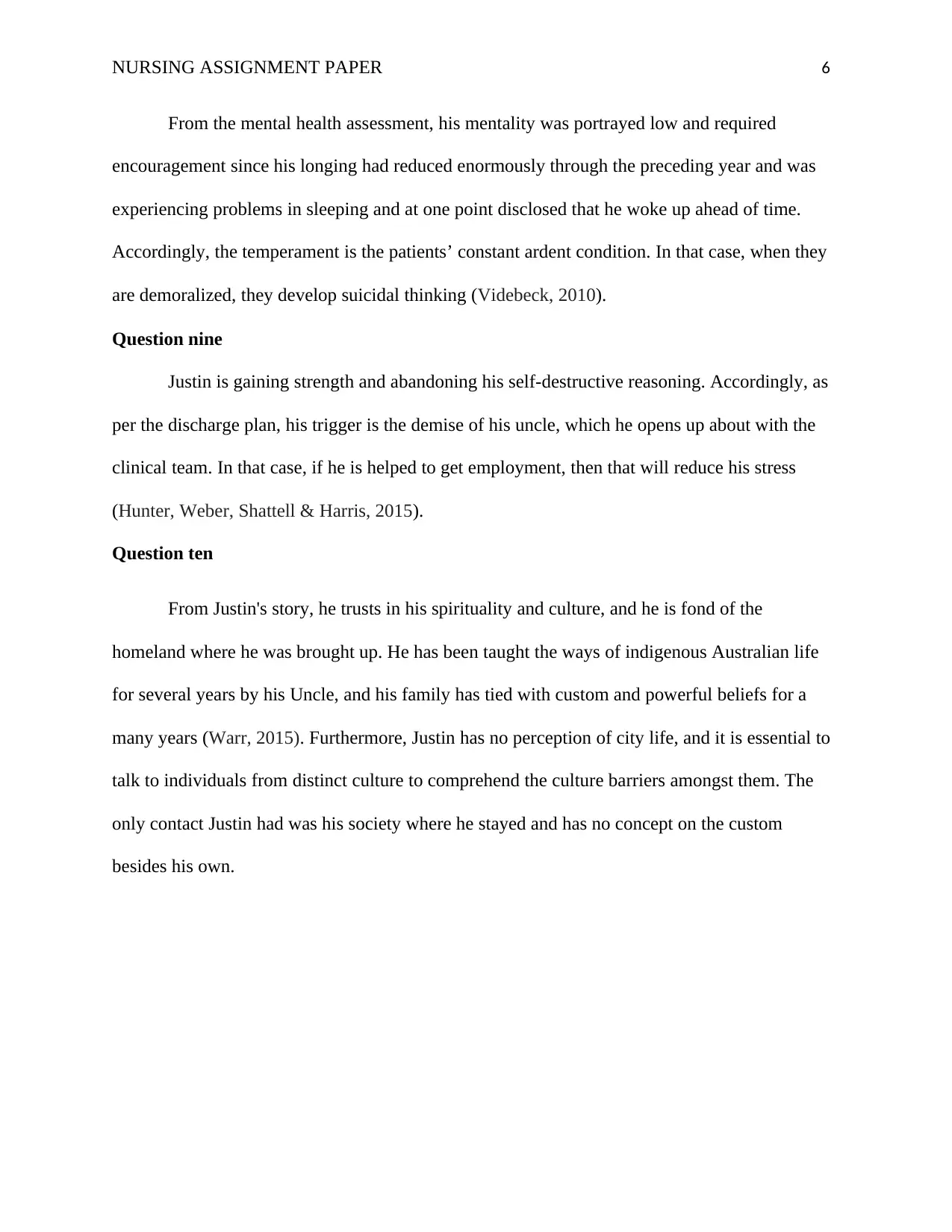
NURSING ASSIGNMENT PAPER 6
From the mental health assessment, his mentality was portrayed low and required
encouragement since his longing had reduced enormously through the preceding year and was
experiencing problems in sleeping and at one point disclosed that he woke up ahead of time.
Accordingly, the temperament is the patients’ constant ardent condition. In that case, when they
are demoralized, they develop suicidal thinking (Videbeck, 2010).
Question nine
Justin is gaining strength and abandoning his self-destructive reasoning. Accordingly, as
per the discharge plan, his trigger is the demise of his uncle, which he opens up about with the
clinical team. In that case, if he is helped to get employment, then that will reduce his stress
(Hunter, Weber, Shattell & Harris, 2015).
Question ten
From Justin's story, he trusts in his spirituality and culture, and he is fond of the
homeland where he was brought up. He has been taught the ways of indigenous Australian life
for several years by his Uncle, and his family has tied with custom and powerful beliefs for a
many years (Warr, 2015). Furthermore, Justin has no perception of city life, and it is essential to
talk to individuals from distinct culture to comprehend the culture barriers amongst them. The
only contact Justin had was his society where he stayed and has no concept on the custom
besides his own.
From the mental health assessment, his mentality was portrayed low and required
encouragement since his longing had reduced enormously through the preceding year and was
experiencing problems in sleeping and at one point disclosed that he woke up ahead of time.
Accordingly, the temperament is the patients’ constant ardent condition. In that case, when they
are demoralized, they develop suicidal thinking (Videbeck, 2010).
Question nine
Justin is gaining strength and abandoning his self-destructive reasoning. Accordingly, as
per the discharge plan, his trigger is the demise of his uncle, which he opens up about with the
clinical team. In that case, if he is helped to get employment, then that will reduce his stress
(Hunter, Weber, Shattell & Harris, 2015).
Question ten
From Justin's story, he trusts in his spirituality and culture, and he is fond of the
homeland where he was brought up. He has been taught the ways of indigenous Australian life
for several years by his Uncle, and his family has tied with custom and powerful beliefs for a
many years (Warr, 2015). Furthermore, Justin has no perception of city life, and it is essential to
talk to individuals from distinct culture to comprehend the culture barriers amongst them. The
only contact Justin had was his society where he stayed and has no concept on the custom
besides his own.
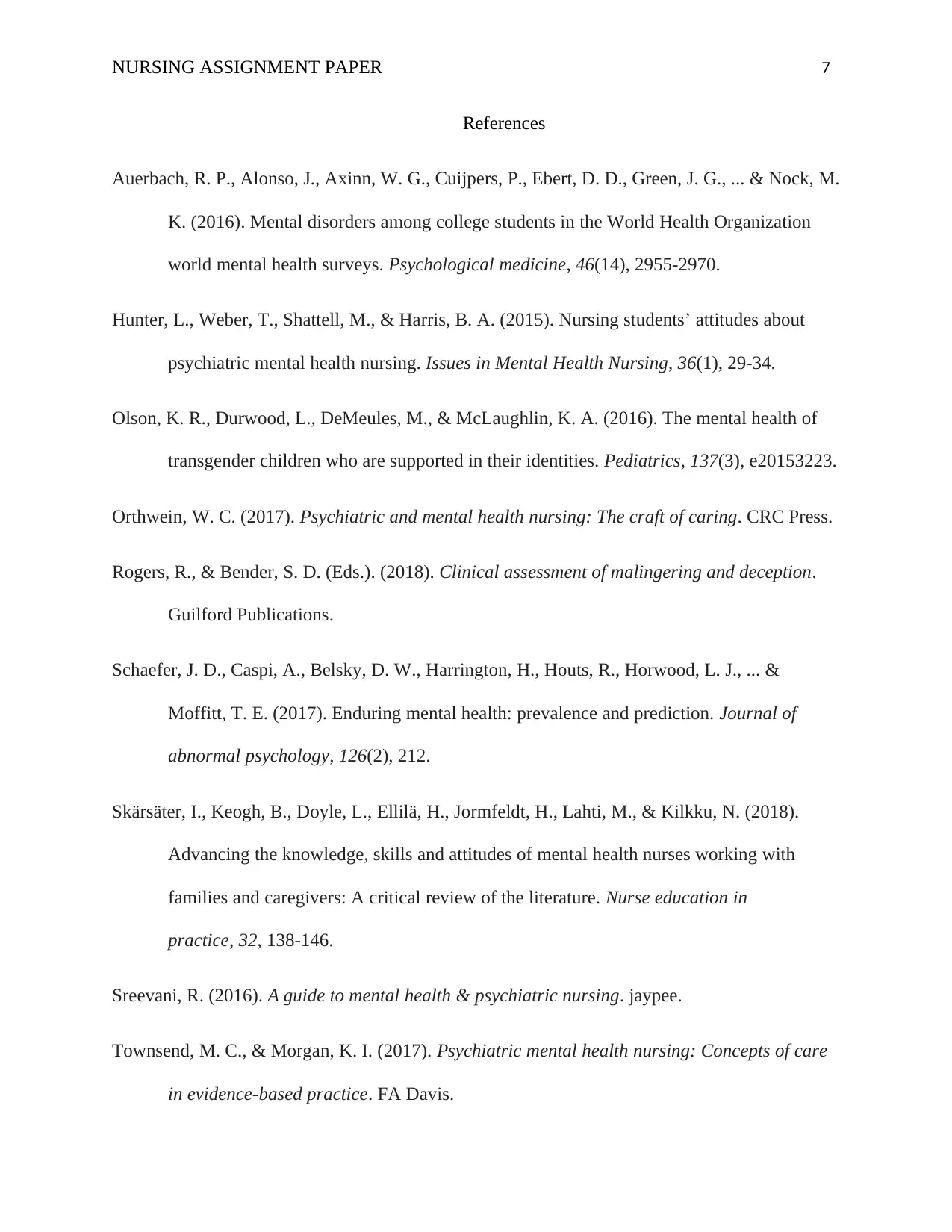
NURSING ASSIGNMENT PAPER 7
References
Auerbach, R. P., Alonso, J., Axinn, W. G., Cuijpers, P., Ebert, D. D., Green, J. G., ... & Nock, M.
K. (2016). Mental disorders among college students in the World Health Organization
world mental health surveys. Psychological medicine, 46(14), 2955-2970.
Hunter, L., Weber, T., Shattell, M., & Harris, B. A. (2015). Nursing students’ attitudes about
psychiatric mental health nursing. Issues in Mental Health Nursing, 36(1), 29-34.
Olson, K. R., Durwood, L., DeMeules, M., & McLaughlin, K. A. (2016). The mental health of
transgender children who are supported in their identities. Pediatrics, 137(3), e20153223.
Orthwein, W. C. (2017). Psychiatric and mental health nursing: The craft of caring. CRC Press.
Rogers, R., & Bender, S. D. (Eds.). (2018). Clinical assessment of malingering and deception.
Guilford Publications.
Schaefer, J. D., Caspi, A., Belsky, D. W., Harrington, H., Houts, R., Horwood, L. J., ... &
Moffitt, T. E. (2017). Enduring mental health: prevalence and prediction. Journal of
abnormal psychology, 126(2), 212.
Skärsäter, I., Keogh, B., Doyle, L., Ellilä, H., Jormfeldt, H., Lahti, M., & Kilkku, N. (2018).
Advancing the knowledge, skills and attitudes of mental health nurses working with
families and caregivers: A critical review of the literature. Nurse education in
practice, 32, 138-146.
Sreevani, R. (2016). A guide to mental health & psychiatric nursing. jaypee.
Townsend, M. C., & Morgan, K. I. (2017). Psychiatric mental health nursing: Concepts of care
in evidence-based practice. FA Davis.
References
Auerbach, R. P., Alonso, J., Axinn, W. G., Cuijpers, P., Ebert, D. D., Green, J. G., ... & Nock, M.
K. (2016). Mental disorders among college students in the World Health Organization
world mental health surveys. Psychological medicine, 46(14), 2955-2970.
Hunter, L., Weber, T., Shattell, M., & Harris, B. A. (2015). Nursing students’ attitudes about
psychiatric mental health nursing. Issues in Mental Health Nursing, 36(1), 29-34.
Olson, K. R., Durwood, L., DeMeules, M., & McLaughlin, K. A. (2016). The mental health of
transgender children who are supported in their identities. Pediatrics, 137(3), e20153223.
Orthwein, W. C. (2017). Psychiatric and mental health nursing: The craft of caring. CRC Press.
Rogers, R., & Bender, S. D. (Eds.). (2018). Clinical assessment of malingering and deception.
Guilford Publications.
Schaefer, J. D., Caspi, A., Belsky, D. W., Harrington, H., Houts, R., Horwood, L. J., ... &
Moffitt, T. E. (2017). Enduring mental health: prevalence and prediction. Journal of
abnormal psychology, 126(2), 212.
Skärsäter, I., Keogh, B., Doyle, L., Ellilä, H., Jormfeldt, H., Lahti, M., & Kilkku, N. (2018).
Advancing the knowledge, skills and attitudes of mental health nurses working with
families and caregivers: A critical review of the literature. Nurse education in
practice, 32, 138-146.
Sreevani, R. (2016). A guide to mental health & psychiatric nursing. jaypee.
Townsend, M. C., & Morgan, K. I. (2017). Psychiatric mental health nursing: Concepts of care
in evidence-based practice. FA Davis.
Paraphrase This Document
Need a fresh take? Get an instant paraphrase of this document with our AI Paraphraser
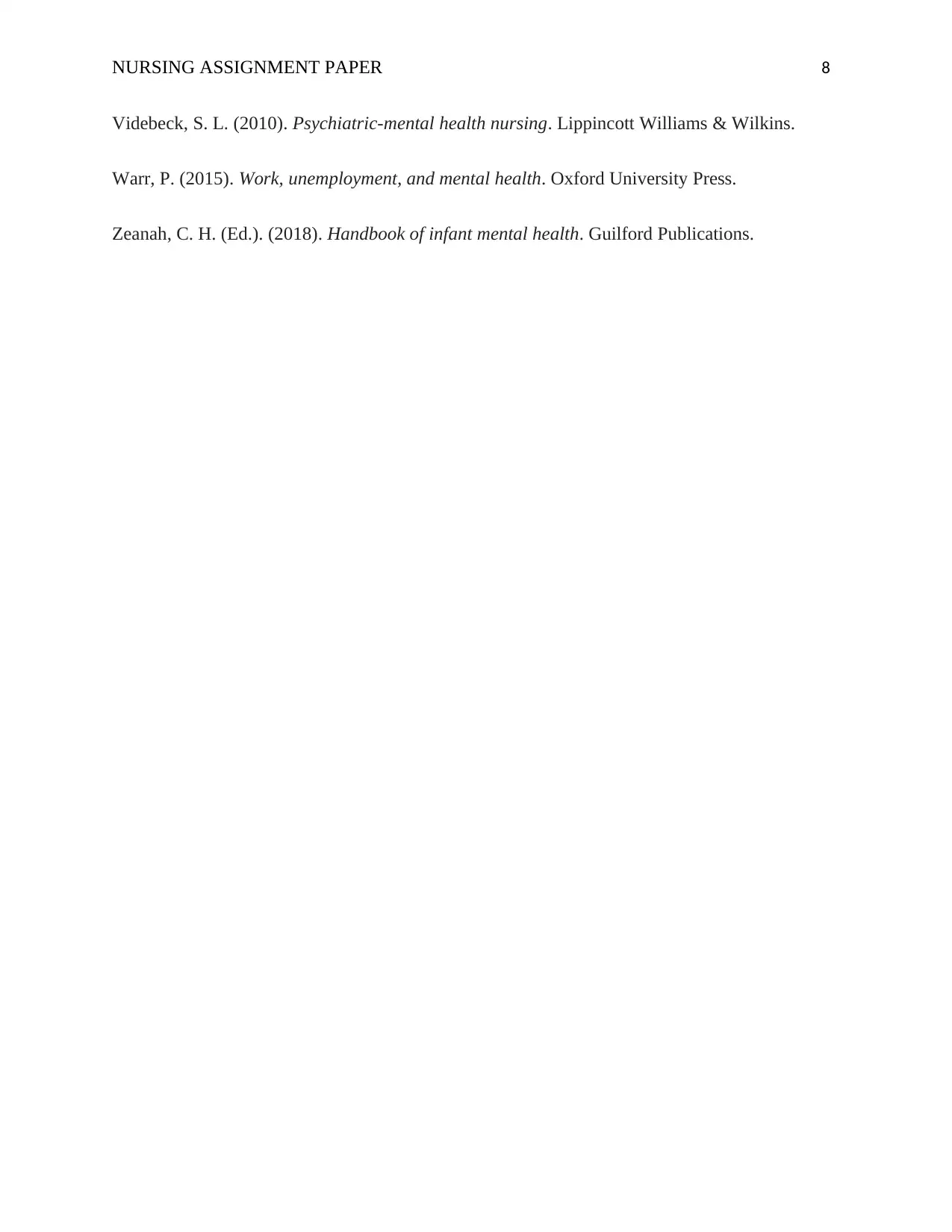
NURSING ASSIGNMENT PAPER 8
Videbeck, S. L. (2010). Psychiatric-mental health nursing. Lippincott Williams & Wilkins.
Warr, P. (2015). Work, unemployment, and mental health. Oxford University Press.
Zeanah, C. H. (Ed.). (2018). Handbook of infant mental health. Guilford Publications.
Videbeck, S. L. (2010). Psychiatric-mental health nursing. Lippincott Williams & Wilkins.
Warr, P. (2015). Work, unemployment, and mental health. Oxford University Press.
Zeanah, C. H. (Ed.). (2018). Handbook of infant mental health. Guilford Publications.
1 out of 8
Related Documents
Your All-in-One AI-Powered Toolkit for Academic Success.
+13062052269
info@desklib.com
Available 24*7 on WhatsApp / Email
![[object Object]](/_next/static/media/star-bottom.7253800d.svg)
Unlock your academic potential
© 2024 | Zucol Services PVT LTD | All rights reserved.





